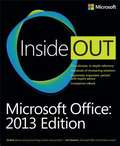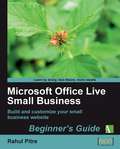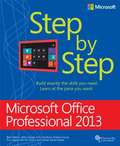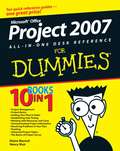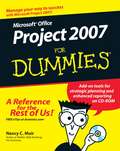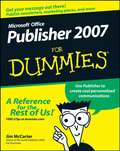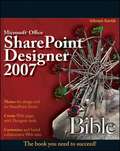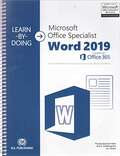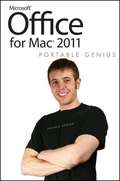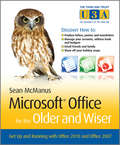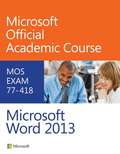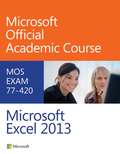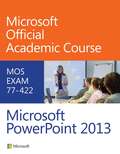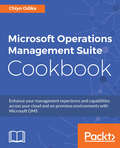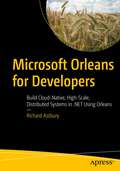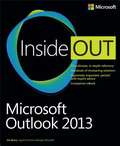- Table View
- List View
Microsoft Office Home and Student Edition 2013 All-in-One For Dummies
by Peter WeverkaThe go-to reference for the new Office Home & Student 2013The Home & Student version of Microsoft Office targets the home and education markets, covering the four applications most used outside the workplace: Word, Excel, PowerPoint, and OneNote. The minibooks in this essential All-in-One guide include real-world examples and projects that cover the new features and capabilities of Office 2013. Straightforward advice and beneficial projects help you to learn the basics of creating a resume in Word, establishing a home budget in Excel, developing a dynamic school presentation with PowerPoint, and taking notes in OneNote. Targets home and school users of Office 2013, who primarily use Word, Excel, PowerPoint, and OneNote Walks you through how to use Office 2013 for everyday projects, such as creating a cover letter in Word or reusable templates in Excel Demonstrates how to jazz up a school presentation with PowerPoint Provides you with straightforward instructions for taking notes in OneNote Shares common Office 2010 tools and details the basics of the Office ribbon Office Home & Student 2013 All-in-One For Dummies is an easy-to-understand guide to the essentials of Office 2013!
Microsoft Office Inside Out: 2013 Edition
by Carl Siechert Ed BottConquer Microsoft Office--from the inside out! You're beyond the basics, so dive right into Microsoft Office--and really put these productivity tools and services to work! This supremely organized reference packs hundreds of timesaving solutions, troubleshooting tips, and workarounds. It's all muscle and no fluff. Discover how the experts tackle Office--and challenge yourself to new levels of mastery. Take advantage of Office in the cloud with Office 365 Get insider tweaks and tips to become more productive Sync your email, calendar, and contacts on multiple devices Organize and edit complex documents with Microsoft Word Enhance Microsoft PowerPoint presentations with rich media Handle data with the Microsoft Excel Quick Analysis tool Get organized with Microsoft OneNote using expert techniques Save, share, and sync documents and settings with SkyDrive Use Microsoft Access, Publisher, and Lync in smarter ways
Microsoft Office Live Small Business: Beginner’s Guide
by Rahul PitreA tutorial in the Beginner's Guide series, offering the reader step-by-step instructions on building and customizing their MOLSB web site from scratch. This book is also packed with tips, tricks, and best practices. Small-business owners who want to build and customize their business web sites on Microsoft's free-to-use platform. No technical knowledge is required.
Microsoft Office Professional 2013 Step by Step
by Echo Swinford Mark Dodge Ciprian Adrian Rusen Andrew Couch Ben M. Schorr Beth Melton Eric LegaultThe smart way to learn Microsoft Office Professional 2013--one step at a time! Experience learning made easy--and quickly teach yourself how to get more done with Microsoft Word, PowerPoint, Excel, Outlook, OneNote, Access, and Publisher. With Step by Step, you set the pace--building and practicing the skills you need, just when you need them! Determine the best Office tool for specific tasks Use Office efficiently on touch-enabled devices Create attractive documents, publications, and presentations Manage your e-mail, calendar, meetings, and communications Put your business data to work with Excel and Access Organize and share your notes and ideas with OneNote
Microsoft Office Project 2007 All-in-One Desk Reference For Dummies
by Elaine Marmel Nancy C. MuirMicrosoft Office Project 2007 All-in-One Desk Reference For Dummies is a compilation of multiple short reference-style books covering Microsoft Project, enhanced by the format of a single, easy-to-use, task-oriented step-by-step package. All-in-One For Dummies books are made up of multiple minibooks that could each stand alone. Each minibook covers one topic completely.This book features a companion Web site where readers can download Microsoft Project add-ins, templates, and author-generated materials. The book also features a gate-fold cheat sheet that contains myriad quick-reference information, tips, and shortcuts for reference when using Microsoft Project 2007.The structure of the book is as follows:Book I: Project BasicsBook II: Structure of a ProjectBook III: Defining Task DetailsBook IV: Establishing Task TimingBook V: Working with Resources and CostsBook VI: Communicating Project InformationBook VII: Resolving Problems with Your PlanBook VIII: TrackingBook IX: Advanced Project TopicsBook X: Project in the Enterprise EnvironmentBook XI: Project Case Studies
Microsoft Office Project 2007 For Dummies
by Nancy C. MuirCreate project plans that make the most of your money and time Get your projects on track, manage resources, and share information online Project 2007 helps you keep your projects on track by providing sophisticated tools for building task outlines and important timing relationships; efficiently assigning people, cost, and material resources; and keeping everyone and everything on schedule. Get an overview of the benefits of Project Server and Project Web Access for communicating with your team and managing your project online. All this on the bonus CD-ROM Tools for creating enhanced graphics and reports Strategic planning and brainstorming tools Project add-ons that improve your time reporting and tracking capabilities For details and complete system requirements, see the CD-ROM appendix. Discover how to Employ the powerful new features of Project 2007 Track down problems with Task Drivers Explore Project's new Visual Reports Get tips for saving time and money on your projects Note: CD-ROM/DVD and other supplementary materials are not included as part of eBook file.
Microsoft Office Publisher 2007 For Dummies
by Jim Mccarter Jacqui Salerno MabinThis is supposed to be the age of instant and constant communication, right? And if you have a business, belong to an organization, or have a cause you want to promote, a great-looking flyer or brochure can say a lot.If you have Microsoft Office Professional, Small Business, or Ultimate on your PC, you already have a great communication tool hidden inside--Publisher 2007. Use it to promote your organization with newsletters, cards, and brochures. This book gets you started with Publisher basics so you can start communicating with your public.Chances are you're not planning to become a Publisher guru; you just want to use Publisher to get some things done. Then Microsoft Office Publisher 2007 For Dummies is just the book for you! It has just what you need to know toUnderstand design basics and plan a pageSet up a flyer or publication and place text and pictures where they work bestUse various Publisher templatesIncorporate images and files from other programsBuild Web sites with PublisherPrepare your creations for printing or posting onlineWhether you're selling a product or service, getting the word out about a not-for-profit organization, or helping out your church, synagogue, or school, Microsoft Office Publisher 2007 For Dummies makes it easy.
Microsoft Office SharePoint Designer 2007 Bible
by Vikram KartikSharePoint Designer allows you to design your own collaborative systems and processes across your enterprises inside the SharePoint platform. This in-depth Bible takes you from the basics through advanced features of SharePoint Designer, from application development to ongoing management after the systems are in place. Written by a SharePoint Designer expert, this guide makes Designer accessible for newcomers but is also full of insight, tips, and techniques for veterans who want to improve their system designs and increase productivity.
Microsoft Office Specialist Excel 2019
by The Development Team at B.E. Publishing and Joy TavanoDesigned for today's interactive, visual learner, this text consists of graphical hands-on lessons that get students instantly engaged in applying Microsoft Excel 2019 skills. Students will learn how to format data, work with numbers and formulas, and create charts and graphs as they acquire the skills needed for school and workplace readiness.
Microsoft Office Specialist Excel Associate 365/2019: Exam Preparation
by Daniel John StineInternationally recognized, certification in Microsoft Excel can open up a world of benefits to you, and Microsoft Office Specialist Excel Associate 365/2019 Exam Preparation includes everything you need to prepare for the exam. Designed for those already familiar with Excel, this book provides detailed information about how and where to take the exam and exactly what to expect. Each chapter is built on one of the five exam topics. Ample study material is provided, including practice exam software and video tutorials for every outcome in the book. The author will guide you like a personal Excel coach, helping you to boost your knowledge, pinpoint skills you need to work on, and gain the confidence to be able to pass the exam. Microsoft Excel Certification is an easily verifiable way to showcase your willingness to learn new skills and software, and it provides a myriad of other benefits as well.
Microsoft Office Specialist Word 2019
by The Development Team at B.E. Publishing and Joy TavanoDesigned for today's interactive, visual learner, this text consists of graphical hands-on lessons that get students instantly engaged in applying Microsoft Word 2019 skills. Students will learn how to format text and paragraphs, work with tables, and design sophisticated multi-page documents as they explore the powerful features and interface of Word 2019.
Microsoft Office Word 2013 Core Certification Guide
by CCI Learning Solutions Inc.Microsoft Office Word 2013 Core Certification Guide Prep for Exam 77-418
Microsoft Office Word 2013 Manual T/a Gregg College Keyboarding And Document Processing (Eleventh Edition)
by Jack E. Johnson Scot Ober Arlene ZimmerlyMicrosoft Office Word 2013 Manual to accompany Gregg College Keyboarding And Document Processing (gdp), eleventh edition
Microsoft Office XP: Marquee Series
by Denise Seguin Nita RutkoskyIn approved courseware for the Microsoft Office user specialist program, Rutkosky and Seguin discuss the components of the latest Windows version: Windows 2000, Internet Explorer 5.5, Word 2002, Excel 2002, Access 2002, Powerpoint 2002, and Outlook 2002. Includes features summaries, skills reviews, and color graphics.
Microsoft Office for Mac 2011 Portable Genius
by Dwight SpiveyA savvy guide to Office 2011 for Mac users Mac users, you don't have to give up one ounce of cool to use Office 2011 on your Mac. Here's the hip guide you need to get the most out of Word, Excel, PowerPoint, and Outlook. Get started with Office 2011, find out what features are shared between apps, and start creating stylish Word docs, lively PowerPoint presentations, awesome Excel reports, and totally organized Outlook lists and calendars. And you'll love the portable size-just perfect for keeping this guide on hand while you work. Features facts, tips, and secrets to help you get the most of out of Office 2011 for Mac Provides the key tools and shortcuts you need to accomplish tasks, without bogging you down in too much detail Covers how to get started with Office, an overview of shared features, and how to use each application in the Office 2011 suite Helps you create smart Word docs, organize your calendar and contacts with Outlook, build compelling PowerPoint presentations, and use Excel formulas and functions to generate reports and analyze data Zero in on the Office 2011 features you use most on your Mac, with Office 2011 for Mac Portable Genius.
Microsoft Office for the Older and Wiser: Get up and running with Office 2010 and Office 2007 (The\third Age Trust (u3a)/older And Wiser Ser. #5)
by Sean McManusAre you new to Microsoft Office software? Looking for instructions that aren't full of complicated computing terms? Microsoft Office for the Older and Wiser can answer all of your queries with its straightforward advice and easy-to-follow layout on using both Office 2010and Office 2007. Completely jargon-free and aimed at those wishing to extend their computing knowledge, Microsoft Office for the Older and Wiser will have you producing documents in Word, spreadsheets in Excel, slideshows in PowerPoint, and emails in Windows Live Mail in no time. Learn how to: Type and format a letter Create an address book Produce personalised invitations Publish a newsletter Form a basic holiday budget Create a photo slideshow Keep a digital recipe book Share and develop ideas over the Internet U3A is a self-help, learning cooperative for those no longer in full-time, gainful employment. Members come together to share their love of learning through educational, creative and leisure activities. U3A offer their members a wide choice of 300+ subjects in areas such as art, foreign languages, music, history, life sciences, literature, poetry, gardening, philosophy, crafts, field studies, archaeology, astronomy and computing. Currently there are over 230,000 members and more than 740 local U3A groups in the UK. Visit U3A online at www.u3a.org.uk
Microsoft Official Academic Course: MICROSOFT WORD 2013
by Microsoft Official Academic CourseThis Word 2013 text is mapped to the Word 2013 certification exam objectives and is designed to re-enforce workforce skills.
Microsoft Official Academic Course: Microsoft Excel 2013
by WileyThis Excel 2013 text is mapped to the Excel 2013 certification exam objectives and is designed to re-enforce workforce skills. With this book students learn to create and edit professional-looking spreadsheets for a variety of purposes and situations.
Microsoft Official Academic Course: Microsoft PowerPoint 2013
by Inc. John Wiley SonsThe PowerPoint 2013 text is mapped to the PowerPoint 2013 certification exam objectives and is designed to re-enforce workforce skills. With this book students learn to create complex slide shows such as product plans, reports, and marketing materials.
Microsoft OneNote 2013 Plain & Simple
by Peter WeverkaGet the full-color, visual guide that makes learning Microsoft OneNote 2013 plain and simple! Follow the book's easy steps and screenshots and clear, concise language to learn the simplest ways to organize information and manage your work and personal lives. Here's WHAT you'll learn: Take notes, organize, and share them Bookmark and tag notes for easier searching Add pictures, drawings, and spreadsheets Handwrite notes and convert them to text Record audio and video notes Access notes from the web or mobile device Here's HOW you'll learn it: Jump in wherever you need answers Follow easy STEPS and SCREENSHOTS to see exactly what to do Get handy TIPS for new techniques and shortcuts Use TRY THIS! exercises to apply what you learn right away
Microsoft Operations Management Suite Cookbook: Enhance your management experience and capabilities across your cloud and on-premises environments with Microsoft OMS
by Chiyo OdikaManage on-premises and cloud IT assets from one consoleKey FeaturesEmpower yourself with practical recipes to collect and analyze operational insights on Windows and Linux servers in your on premises datacenters and in any public cloud environments such as Azure and AWS.Build capabilities through practical tasks and techniques to collect and analyze machine dataAddress business challenges and discover means to accommodate workloads and instances in a low cost mannerBook DescriptionMicrosoft Operations Management Suite Cookbook begins with an overview of how to hit the ground running with OMS insights and analytics. Next, you will learn to search and analyze data to retrieve actionable insights, review alert generation from the analyzed data, and use basic and advanced Log search queries in Azure Log Analytics. Following this, you will explore some other management solutions that provide functionality related to workload assessment, application dependency mapping, automation and configuration management, and security and compliance. You will also become well versed with the data protection and recovery functionalities of OMS Protection and Recovery, and learn how to use Azure Automation components and features in OMS. Finally you will learn how to evaluate key considerations for using the Security and Audit solution, and working with Security and Compliance in OMS.By the end of the book, you will be able to configure and utilize solution offerings in OMS, understand OMS workflows, how to unlock insights, integrate capabilities into new or existing workflows, manage configurations, and automate tasks and processes.What you will learnUnderstand the important architectural considerations and strategies for OMSUse advanced search query commands and strategies to derive insights from indexed dataMake use of alerting in OMS such as alert actions, and available options for the entire lifecycle of the alertDiscover some practical tips for monitoring Azure container service containers and clusters using OMSReview and use the backup options available through the Azure backup service, as well as data recovery options available through Azure Site Recovery (ASR)Understand how to advance important DevOps concepts within your IT organizationLearn how to manage configurations and automate processWho this book is forThis book is written for the IT professional and general reader who is interested in technology themes such as DevOps, Big Data Analytics, and digital transformation concepts. Azure and other cloud platform administrators, cloud professionals, and technology analysts who would like to solve everyday problems quickly and efficiently with hybrid management tools available in the Microsoft product ecosystem will derive much value from this book. Prior experience with OMS 2012 would be helpful.
Microsoft Orleans for Developers: Build Cloud-Native, High-Scale, Distributed Systems in .NET Using Orleans
by Richard AstburyUse a simple programming model and the .NET language of your choice to build large distributed systems. This book teaches you the Microsoft Orleans framework.Even well-versed professional software developers with expertise in C# (or another language) find themselves unequipped to meet the challenges of distributed systems as infrastructure moves to multi-core; multiple computers are being used for scale, redundancy, and cloud computing; and multi-region deployment is taking place.Orleans handles many of the concerns of distributed computing and cloud infrastructure, allowing you to concentrate on writing application logic. What You Will Learn Know the key concepts for building distributed systemsGain a background in the origin and evolution of Orleans, and why it is important for your projectsDive into each of the features available in Orleans by building an example applicationDevelop troubleshooting skills for fixing bugs and running diagnosticsAchieve performance optimization and advanced configurationUse the Orleans Dashboard to discern valuable insight in system performance Who This Book Is ForExperienced C# developers who want to build a new high-scale application (perhaps for an IoT requirement) and are interested in learning the concepts and features available in Orleans
Microsoft Outlook 2013 Inside Out
by Jim BoyceConquer Microsoft Outlook--from the inside out! Dive into Outlook 2013--and really take control of your communications and workday! This supremely organized reference packs hundreds of timesaving solutions, troubleshooting tips, and workarounds. It's all muscle and no fluff. Discover how the experts tackle Outlook--and challenge yourself to new levels of mastery. Connect to Microsoft SharePoint and social networks with Outlook Customize and configure Outlook with advanced setup options Expertly manage your contacts and other critical data Optimize team efficiency by sharing your calendar and tasks Collaborate through SharePoint libraries and files Encrypt your data, protect against viruses, and filter spam Use Outlook 2013 as a Microsoft Exchange Server client Communicate and collaborate using Microsoft Lync and Skype Work with Outlook using a web browser or mobile device For Intermediate and Advanced Users
Microsoft Outlook 2013 Plain & Simple
by Jim Boyce<p>Get the full-color, visual guide that makes learning Microsoft Outlook 2013 plain and simple! Follow the book’s easy steps and screenshots and clear, concise language to learn how to stay productive and keep in touch with all of your personal, business, and social media networks.</p>
Microsoft Outlook 2013 Step by Step
by Joan Lambert Joyce CoxExperience learning made easy--and quickly teach yourself how to stay organized and stay connected using Outlook 2013. With Step by Step, you set the pace--building and practicing the skills you need, just when you them! Includes downloadable practice files and a companion eBook. Set up your email and social media accounts Send, search, filter, and organize messages Manage one or more calendars, and share your schedule Help protect your inbox and outbox Create and track tasks, to-do lists, and appointments

